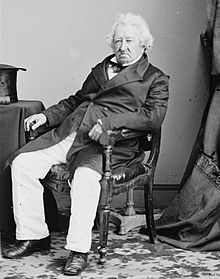Gulian C. Verplanck
Gulian Crommelin Verplanck (born August 6, 1786 in New York City , † March 18, 1870 ibid) was an American politician . Between 1825 and 1833 he represented New York State in the US House of Representatives .
Career
Gulian Verplanck was the son of Congressman Daniel C. Verplanck (1762-1834). In 1801 he graduated from Columbia College , now Columbia University . After completing a law degree and being admitted to the bar in 1807, he began to work in this profession. At the same time he embarked on a political career. Between 1820 and 1823 he was a member of the New York State Assembly . From 1821 to 1824 he was on the faculty of the General Theological Seminary in New York City. Between 1823 and 1865 he was head of the city hospital; from 1826 to 1870 he was a regent board member of the University of the State of New York . Since 1858 he was their vice-chancellor.
In the 1820s he joined the movement around the future US President Andrew Jackson and became a member of the Democratic Party founded by this in 1828 . In the congressional elections of 1824 Verplanck was elected to the US House of Representatives in Washington, DC in the third constituency of New York , where he succeeded Peter Sharpe on March 4, 1825 . He took one of three seats in his district; this was a special regulation for New York State at the time. After three re-elections, he was able to complete four legislative terms in Congress by March 3, 1833 . From 1831 he was chairman of the Committee on Ways and Means . Since President Jackson took office in 1829, there has been heated debate inside and outside of Congress about its policies. It was about the controversial enforcement of the Indian Removal Act , the conflict with the state of South Carolina , which culminated in the nullification crisis , and the banking policy of the president. The discussions about the smashing of the Bundesbank by President Jackson led to Verplanck's break with him and the Democratic Party, which he then left. As a result, he was no longer nominated for re-election in 1832.
In the 1830s, Verplanck joined the Whig Party . In 1834 he ran unsuccessfully for the office of mayor of New York. Between 1838 and 1841 he was a member of the New York Senate . From 1846 and 1870 he was chairman of his state's immigration commission. In 1867 and 1868 he was a member of a New York State Constitutional Convention. Politically, he switched back to the Democrats in the 1850s, to whom he belonged for the rest of his life. Gulian Verplanck died on March 18, 1870 in New York City.
Without ever having been an artist or an architect himself, Gulian Crommelin Verplanck was also one of the early honorary members ( Honorary NA ) of the newly founded National Academy of Design from 1830 (like several other New York politicians) .
Individual evidence
- ↑ nationalacademy.org: Past Academicians "V" / Verplanck, Gulian Crommelin Honorary 1830 ( Memento of the original from April 2, 2015 in the Internet Archive ) Info: The archive link was inserted automatically and has not yet been checked. Please check the original and archive link according to the instructions and then remove this notice. (accessed on July 18, 2015)
Web links
- Gulian C. Verplanck in the Biographical Directory of the United States Congress (English)
| predecessor | Office | successor |
|---|---|---|
| Peter Sharpe |
United States House of Representatives for New York (3rd constituency) with Churchill C. Cambreleng and Jeromus Johnson March 4, 1825 - March 3, 1833 |
Cornelius Van Wyck Lawrence |
| personal data | |
|---|---|
| SURNAME | Verplanck, Gulian C. |
| ALTERNATIVE NAMES | Verplanck, Gulian Crommelin (full name) |
| BRIEF DESCRIPTION | American politician |
| DATE OF BIRTH | August 6, 1786 |
| PLACE OF BIRTH | New York City |
| DATE OF DEATH | March 18, 1870 |
| Place of death | New York City |

